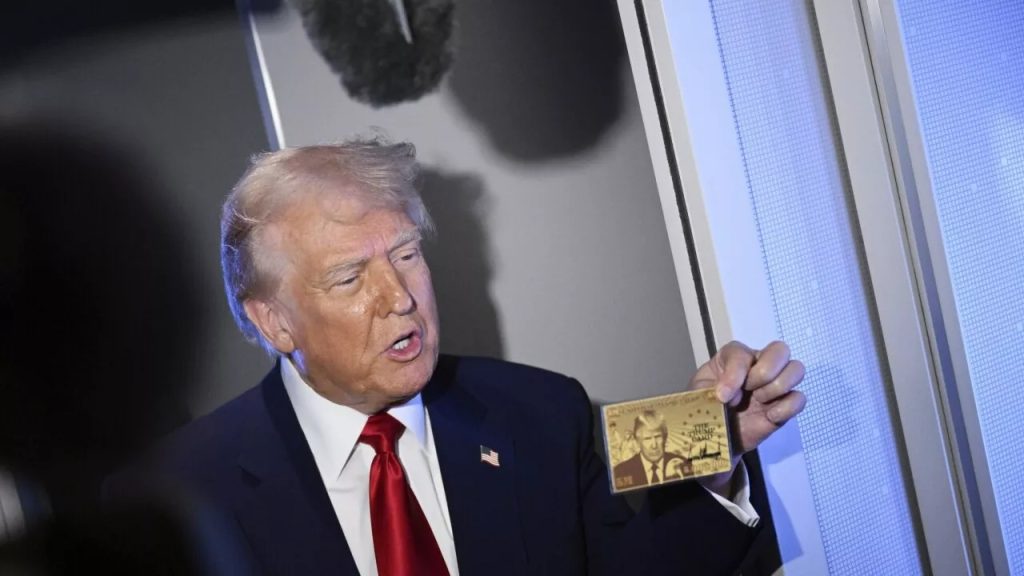Trump Launches $5M ‘Gold Card’ Visa Amid Market Turmoil
Market Chaos and Controversial Announcement

President Donald Trump chose a dramatic moment to introduce his $5 million “Gold Card” visa program. The announcement came as the S&P 500 experienced its sharpest one-day drop since 2020, falling 4.8%. The market turbulence was spurred by Trump’s global tariff proposals, which economists warned could lead to higher consumer prices and layoffs. Against this backdrop, Trump pitched the visa program aboard Air Force One, calling it “green-card privileges plus” for wealthy immigrants willing to invest $5 million.
The Gold Card features Trump’s face alongside the Statue of Liberty, symbolizing a shift from the older EB-5 investor visa program. Commerce Secretary Howard Lutnick criticized the EB-5 for being “fraud-riddled,” boasting that the new program not only raises standards but also simplifies the process. Early reports claim that 1,000 Gold Cards were sold in just 24 hours. With over 37 million ultra-wealthy individuals worldwide eligible, the program could generate billions in investment capital.
Economic Implications and Criticism

The timing of the announcement left many analysts puzzled. Trump’s global tariffs triggered steep declines in manufacturing and retail stocks. Economists are projecting a potential 15-20% increase in consumer prices for imported goods. Georgetown economist Mariana Cruz criticized the administration’s priorities. She argued that while the Gold Card might attract capital, it offers little relief to vulnerable industries or American workers.
Critics in Congress also took aim at the program. Rep. Ro Khanna (D-CA) pointed to immigrant success stories like Google’s Sergey Brin and Microsoft’s Satya Nadella—figures who shaped the U.S. economy without millions in starting capital. Studies show that immigrants drive business creation at rates higher than native-born citizens. More than half of U.S.-based unicorn startups had immigrant founders, underscoring their importance to economic growth.
Projections and Legal Concerns

The Trump administration is banking on substantial economic returns. Officials estimate $50 billion in annual revenue if the program reaches adoption targets. Commerce Secretary Lutnick claimed each Gold Card holder could generate 12 permanent jobs through required business investments. However, similar promises under the EB-5 program often resulted in luxury real estate development instead of job creation. Urban Institute research revealed that only 22% of EB-5 funds reached economically distressed regions.
Some are raising concerns about the card’s design and legality. The Gold Card prominently features Trump’s portrait, breaking from traditional government document norms. Its promise to fast-track citizenship is another sticking point. Legal experts are questioning whether the program violates existing naturalization requirements, potentially setting up court challenges in the months ahead. Immigration attorneys are already reporting increased interest overseas, especially from wealthy individuals in China and the Middle East.
Political Fallout and Future Developments
The Gold Card rollout coincides with growing political polarization. House Speaker Mike Johnson (R-LA) praised the initiative, calling it a “celebration of entrepreneurial spirit.” Progressive lawmakers, however, promise to introduce legislation to block the program. They argue it commodifies citizenship and prioritizes the wealthy while ignoring merit-based pathways.
As inflation continues to rise and manufacturing confidence hits new lows, the program’s future is uncertain. While the administration estimates significant economic benefits, skeptics fear unintended consequences. For now, Trump’s latest policy shift highlights stark divisions in how America sees its immigration system and economic priorities.

